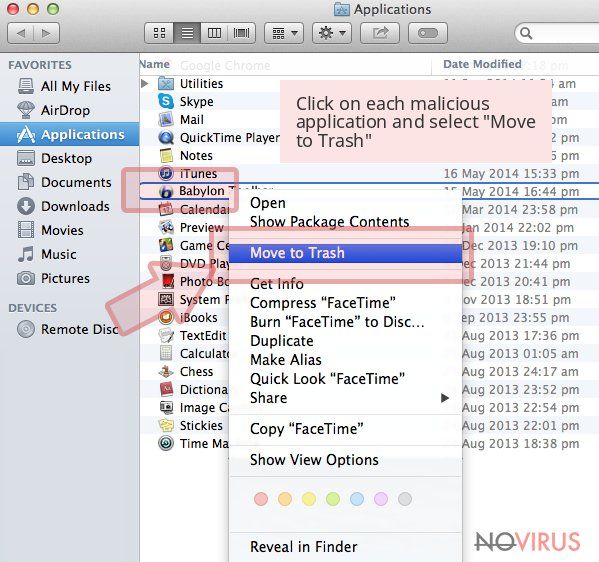Remove Browse for the Cause (Uninstall Instructions) - Dec 2016 updated
Browse for the Cause Removal Guide
Description of Browse for the Cause virus
What is known about BrowseForTheCause virus?
BrowseForTheCause is a suspicious add-on that is promoted as a unique possibility to donate money for charity for free. Indeed, it sounds really altruistic and generous; however, we have some doubt about this services. This application can secretly sneak inside the computer and bombards web browsers with an excessive amount of commercial content. Even though people can download this app from the official website, most of the time so-called BrowseForTheCause virus gets inside the computers with the assistance of other free programs that users download from the Internet. We have to mention that it’s more a potentially unwanted program (PUP)[1] than a virus. It cannot harm your computer and steal your personal information. It might be only blamed for crashing or freezing the browser. BrowseForTheCause adware[2] is extremely annoying because, after hijack, it bombards affected browsers with pop-ups, banners, in-text ads and other forms of online advertisements. The only possible ways to run away from these problems is to throw away your computer or initiate BrowseForTheCause removal. We believe that the latter method seems more suitable. So, install FortectIntego, run a full system scan and get rid of this computer infection.
BrowseForTheCause ads will follow you everywhere. Keep in mind that they might show up on the legitimate websites as well. They might overlay the original advertisements and look like real ones. Recognising the fraudulent ads from the real ones might be hard[3]. Some ads might cover the article you want to read or other necessary information; besides, they might not have a close button, or after clicking on it, you might be still redirected to the promotional website. BrowseForTheCause redirect tendencies are annoying and concerning. After a click on the eye-catchy or interesting ad, you might end up on completely different and irrelevant website that has nothing in common with advertised content. Adware can deliver personalised ads based on your latest search queries and browsing history. Keep in mind that the purpose of them is to encourage you to click because developers generate pay-per-click[4] revenue. Where you end up after the click or what might happen on the third-party website, don’t bother the developers. Unfortunately, you might end up on a malicious or infected site that has been created for spreading malware. For this reason, you should remove BrowseForTheCause add-on as soon as it shows the first signs of the appearance.

Where can you meet this strange adware program?
Users can download Browse for the cause add-on straight from the developer’s website; however, it rarely happens. The developers distribute it using a sneaky method called software bundling[5]. This strategy allows adding PUP as an optional component and hiding it under Standard or Basic installation wizard. So, BrowsefortheCause hijack might occur when you install new programs using these settings. Fortunately, it’s possible to stop these PUPs from stepping inside. Just opt for Advanced or Custom installation mode and attentively follow each step. When you encounter the checkbox with additional applications, deselect them all and continue the installation.
Getting rid of Browse for the cause virus
We do not recommend keeping this suspicious add-on on your PC. There are other ways to donate money to charity, and those ways are more effective and clearer. The easiest way to remove BrowseForTheCause is to use anti-malware, anti-spyware or antivirus programs. However, keep in mind that you should invest in professional and reliable security tool. Free or cheap programs might not be able to clean adware and all its components; besides, free tools will not protect your computer in the future as professional ones. However, if you do not want to use additional software for BrowseForTheCause removal, you can check manual removal guidelines below. Please, be very attentive and remove all programs and extensions that might be related to this program.
You may remove virus damage with a help of FortectIntego. SpyHunter 5Combo Cleaner and Malwarebytes are recommended to detect potentially unwanted programs and viruses with all their files and registry entries that are related to them.
Getting rid of Browse for the Cause. Follow these steps
Uninstall Browse for the Cause in Windows systems
If your computer has been infected with Browse For The Cause virus, you should check if other PUPs haven’t managed to get inside the computer. If you see Snap.do, Search.Snap.do, DefaultTab and similar programs installed on your PC, delete them immediately.
Terminate suspicious programs from Windows 10/8 machines by following these instructions:
- Type Control Panel into Windows search and once the result shows up hit Enter.
- Under Programs, choose Uninstall a program.
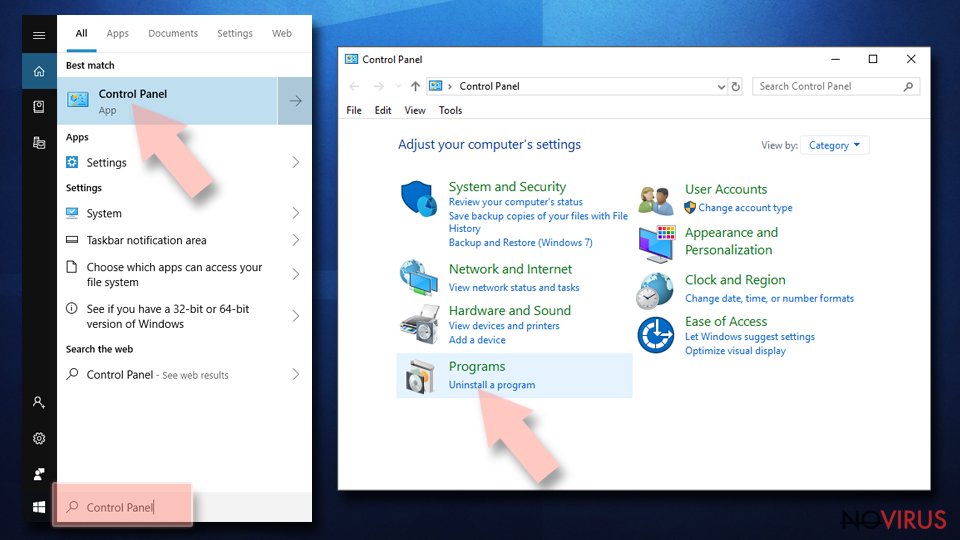
- Find components related to suspicious programs.
- Right-click on the application and select Uninstall.
- Click Yes when User Account Control shows up.
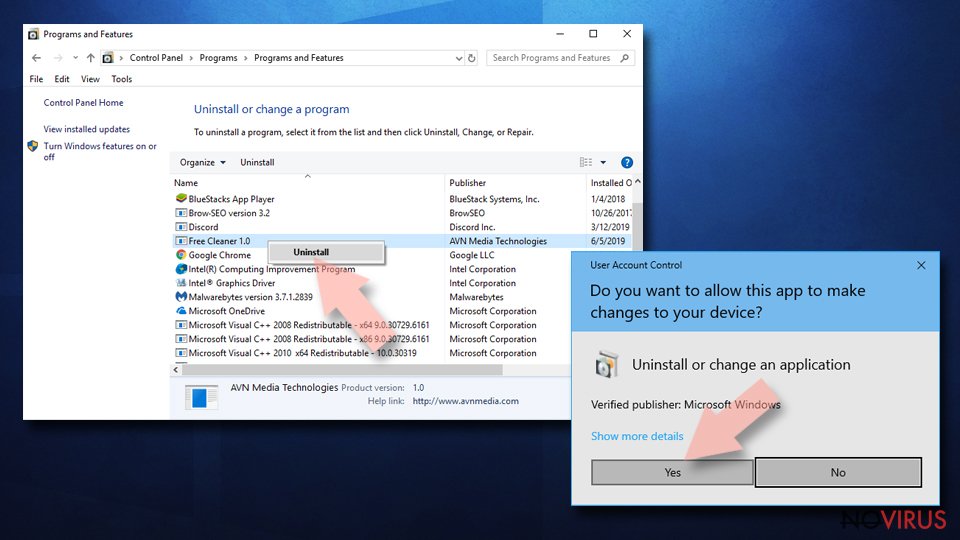
- Wait for the process of uninstallation to be done and click OK.
Windows 7/XP instructions:
- Click on Windows Start and go to Control Panel on the right pane.
- Choose Add/Remove Programs.
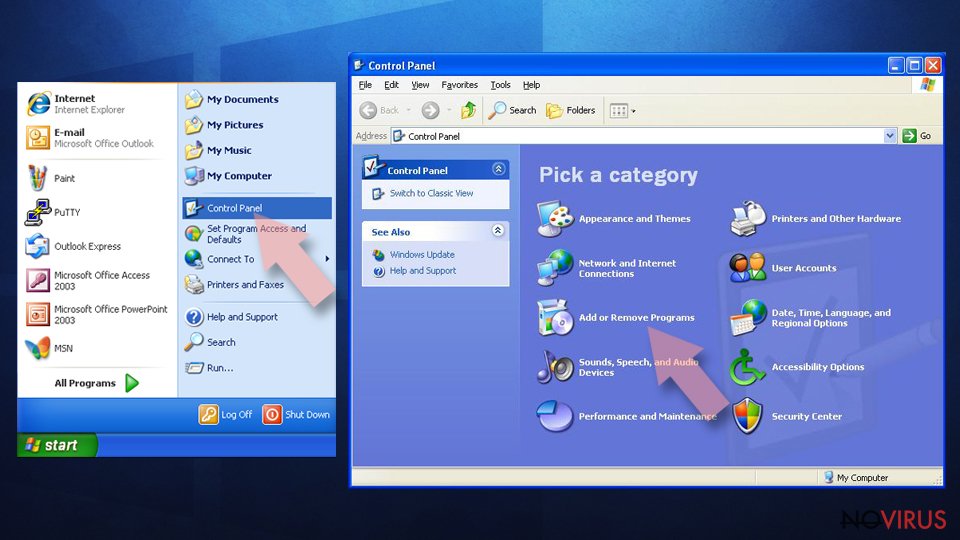
- Select Uninstall a program under Programs in Control Panel.
- Click once on the unwanted application.
- Click Uninstall/Change at the top.
- Confirm with Yes.
- Click OK and finish the removal.
Uninstall Browse for the Cause in Mac OS X system
Find all adware-related components and uninstall them from the system. Also, look for these applications and remove them as well: Snap.do, Search.Snap.do and DefaultTab and similar.
-
Users who use OS X should click on Go button, which can be found at the top left corner of the screen and select Applications.

-
Wait until you see Applications folder and look for Browse for the Cause or any other suspicious programs on it. Now right click on every of such entries and select Move to Trash.

Delete Browse for the Cause from Microsoft Edge
If you got infected with adware, make sure that it haven’t installed any suspicious extensions. If you find something questionable, uninstall it as shown below.
Delete suspicious extensions from MS Edge:
- Go to the Menu by clicking on the three horizontal dots at the top-right.
- Then pick Extensions.
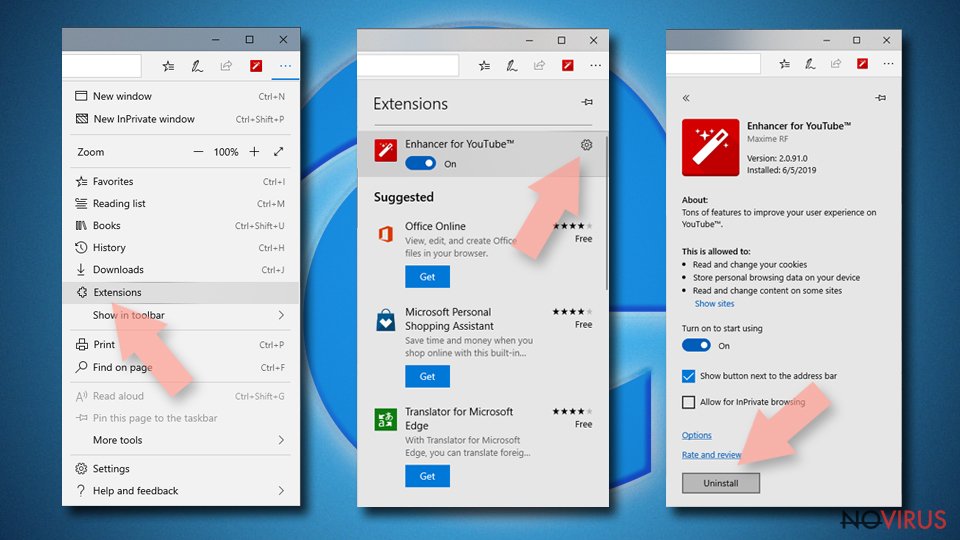
- Choose the unwanted add-ons on the list and click on the Gear icon.
- Click on Uninstall at the bottom.
Clear cookies and other data:
- Click on the Menu and from the context menu select Privacy & security.
- Under Clear browsing data, select Choose what to clear.
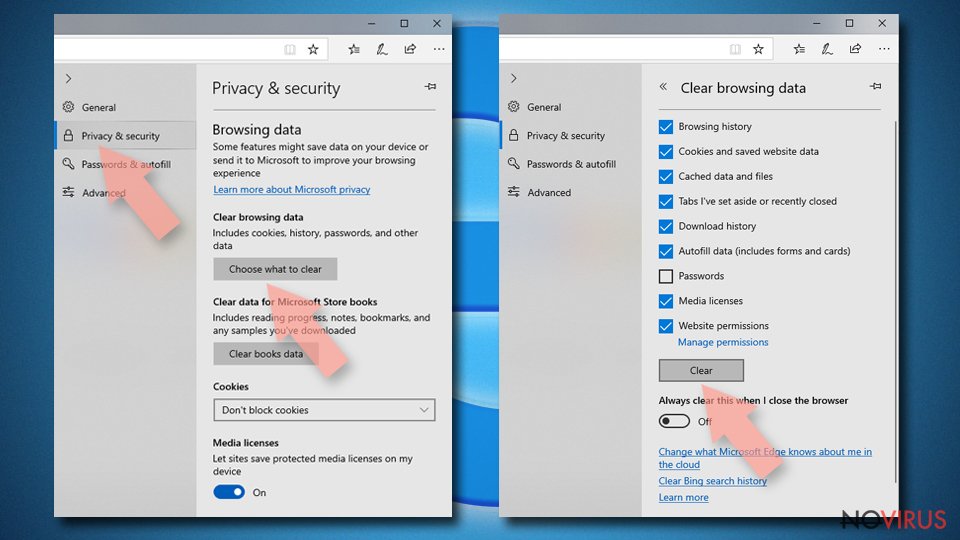
- Choose everything except passwords, and click on Clear.
Alter new tab and homepage settings:
- Click the menu icon and choose Settings.
- Then find On startup section.
- Click Disable if you found any suspicious domain.
Reset MS Edge fully:
- Click on the keyboard Ctrl + Shift + Esc to open Task Manager.
- Choose More details arrow at the bottom.
- Go to Details tab.
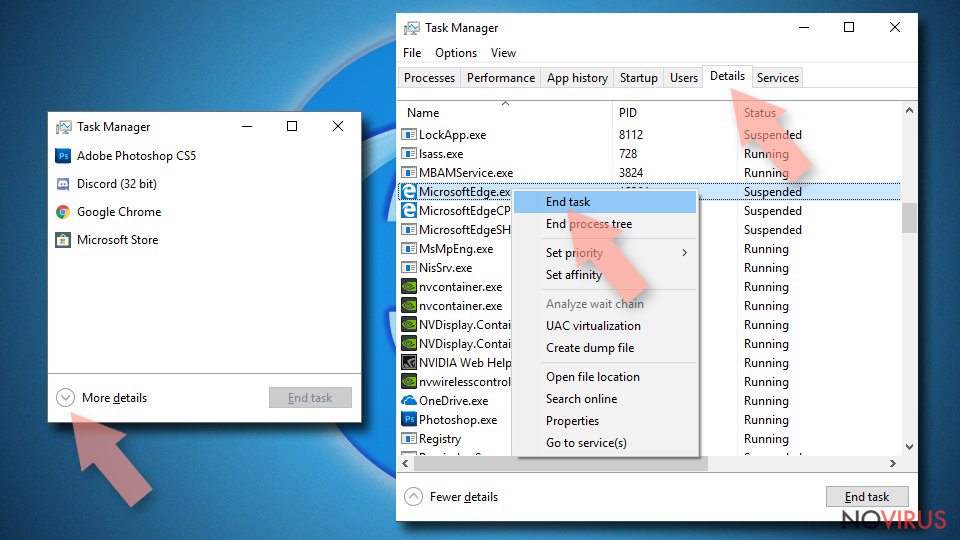
- Now scroll down and locate every entry with Microsoft Edge name in it.
- Right-click on each of them and select End Task to stop MS Edge from running.
When none of the above solves the issue, you might need an advanced Edge reset method, but you need to backup your data before proceeding.
- Find the following folder on the PC: C:\\Users\\%username%\\AppData\\Local\\Packages\\Microsoft.MicrosoftEdge_8wekyb3d8bbwe.
- Press Ctrl + A on your keyboard to select all folders.
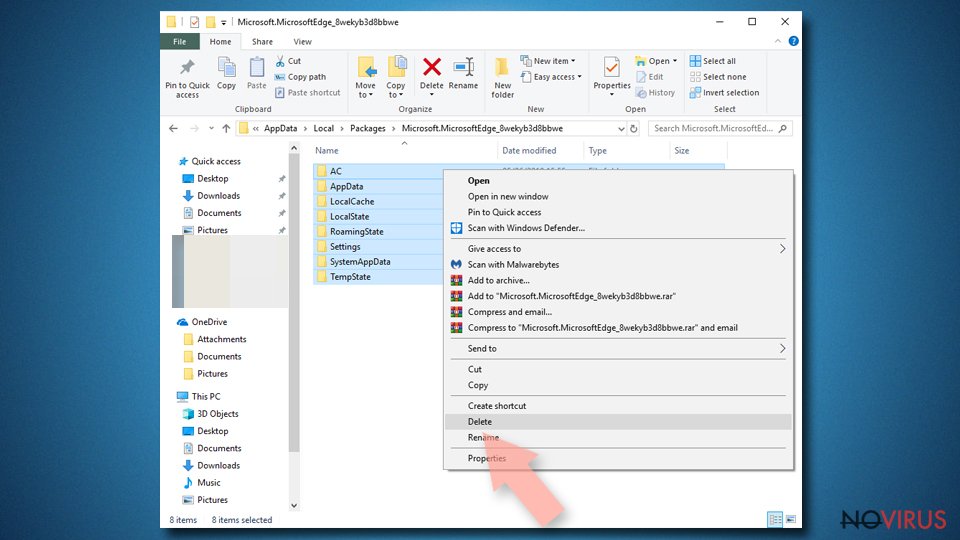
- Right-click on the selection and choose Delete
- Right-click on the Start button and pick Windows PowerShell (Admin).
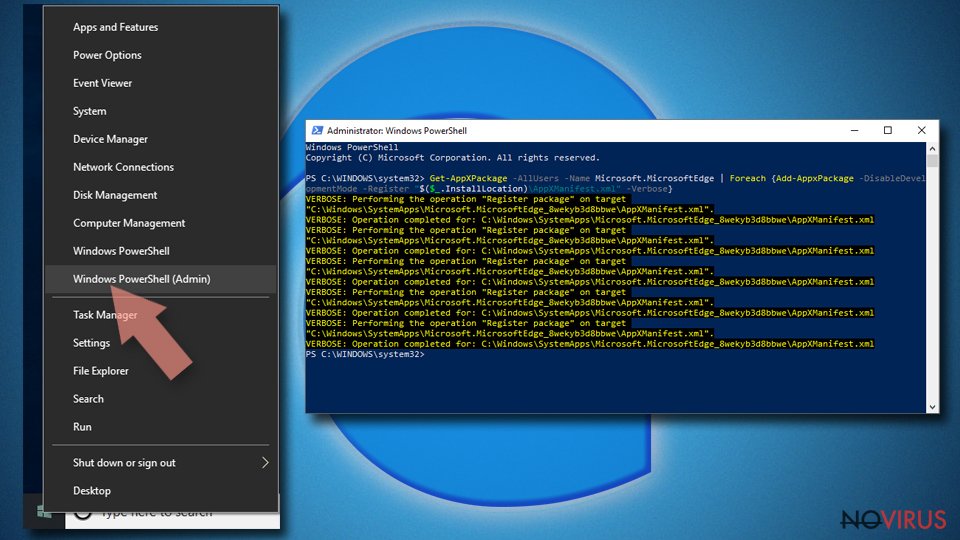
- Copy and paste the following command, and then press Enter:
Get-AppXPackage -AllUsers -Name Microsoft.MicrosoftEdge | Foreach {Add-AppxPackage -DisableDevelopmentMode -Register “$($_.InstallLocation)\\AppXManifest.xml” -Verbose
Instructions for Chromium-based Edge
Delete extensions:
- Open Edge and click Settings.
- Then find Extensions.
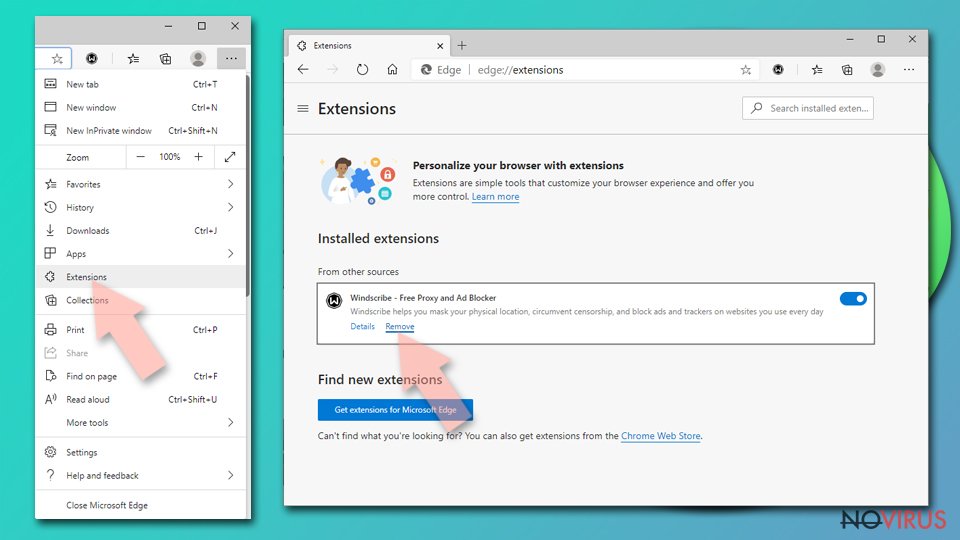
- Delete unwanted extensions with the Remove.
Clear cache and site data:
- Click on Menu and then Settings.
- Find Privacy and services.
- Locate Clear browsing data, then click Choose what to clear.
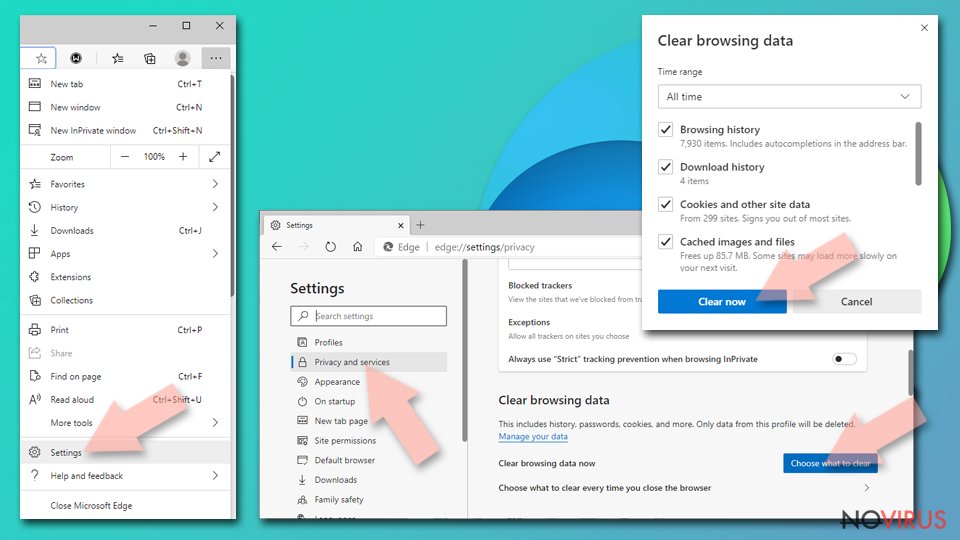
- Time range.
- Click All time.
- Select Clear now.
Reset Chromium-based MS Edge browser fully:
- Go to Settings.
- On the left side, choose Reset settings.
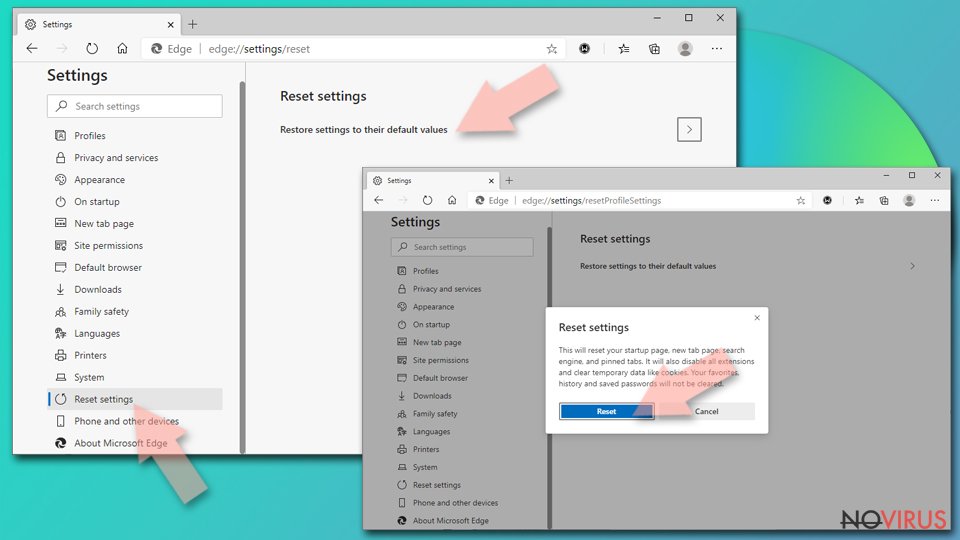
- Select Restore settings to their default values.
- Click Reset.
Delete Browse for the Cause from Mozilla Firefox (FF)
Browse For The Cause might not be the only add-on that has been accidentally installed to Mozilla Firefox. Therefore, check the list of extensions and remove all suspicious entries.
Remove suspicious Firefox extensions:
- Open Mozilla Firefox browser and click on the three horizontal lines at the top-right to open the menu.
- Select Add-ons in the context menu.
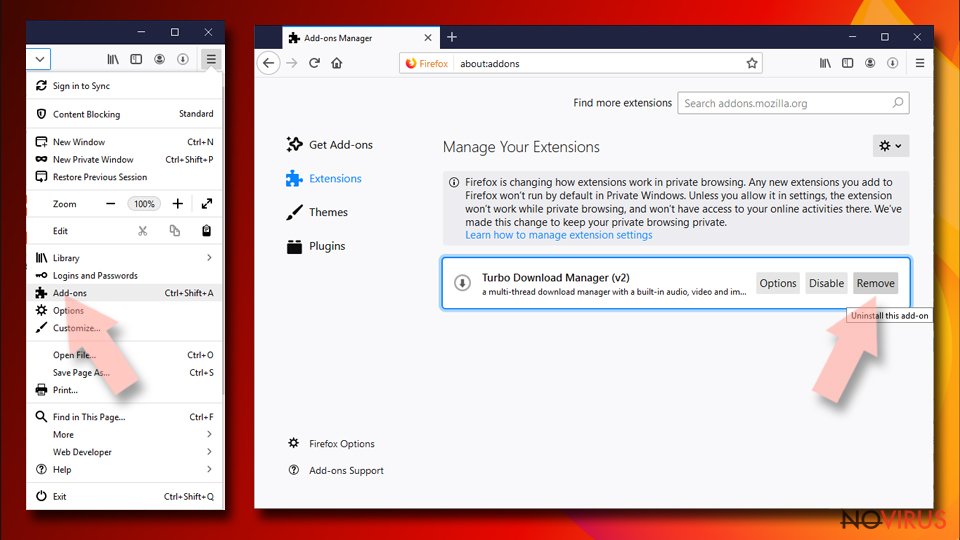
- Choose plugins that are creating issues and select Remove.
Reset the homepage on the browser:
- Click three horizontal lines at the top right corner.
- This time select Options.
- Under Home section, enter your preferred site for the homepage that will open every time you launch Mozilla Firefox.
Clear cookies and site data:
- Click Menu and pick Options.
- Find the Privacy & Security section.
- Scroll down to choose Cookies and Site Data.
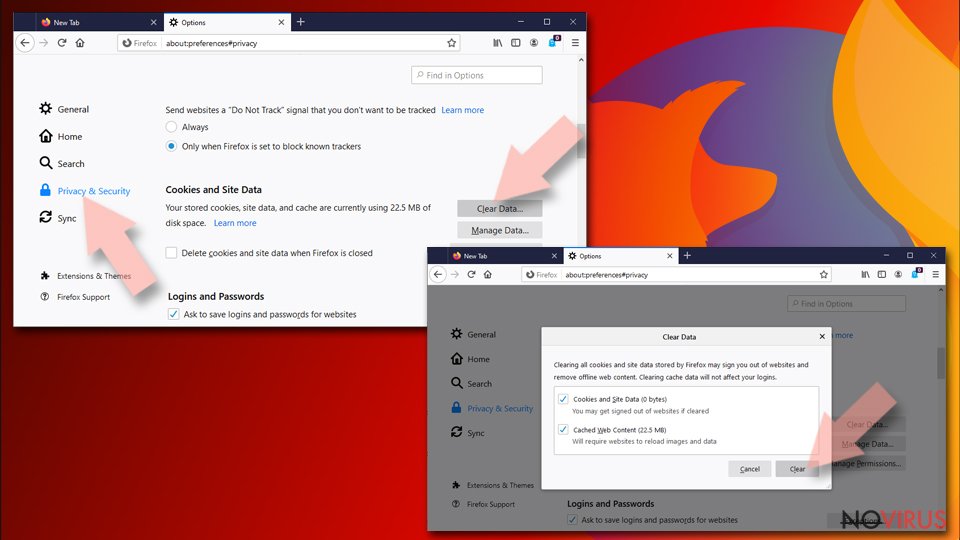
- Click on Clear Data… option.
- Click Cookies and Site Data, Cached Web Content and press Clear.
Reset Mozilla Firefox:
If none of the steps above helped you, reset Mozilla Firefox as follows:
- Open Mozilla Firefox and go to the menu.
- Click Help and then choose Troubleshooting Information.
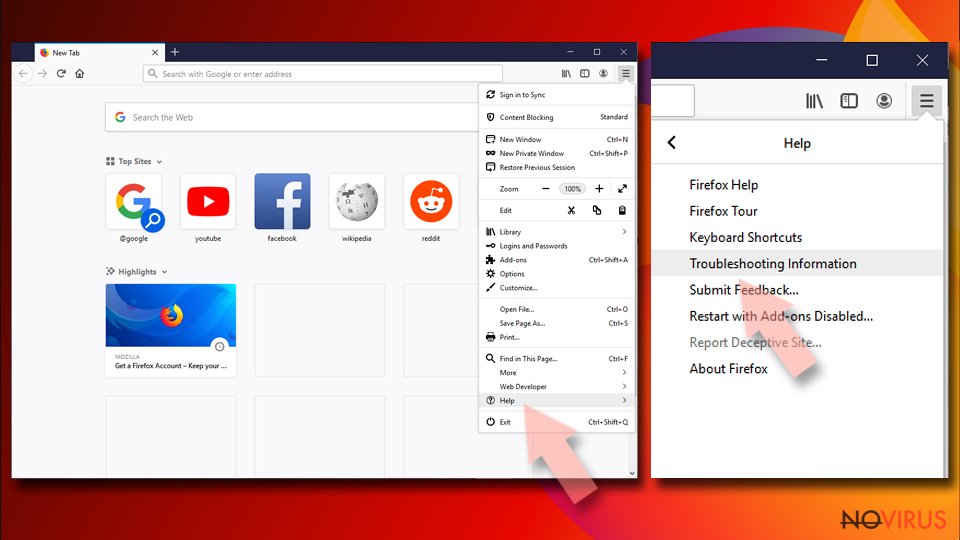
- Locate Give Firefox a tune-up section, click on Refresh Firefox…
- Confirm the action by pressing on Refresh Firefox on the pop-up.
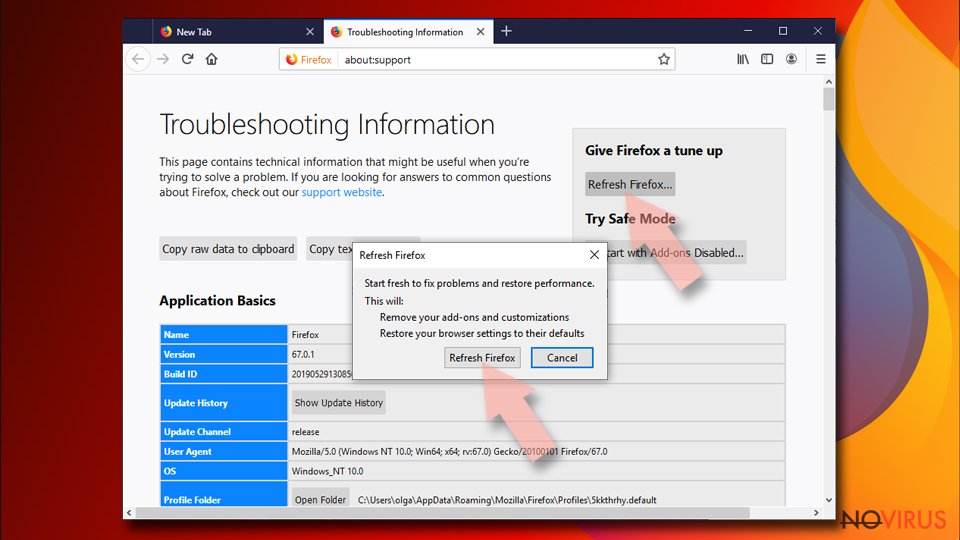
Chrome browser reset
Look through the list of extensions and remove all extensions, add-ons or toolbars that might be related to BrowseForTheCause.
Find and remove suspicious extensions from Google Chrome:
- In Google Chrome, open the Menu by clicking three vertical dots at the top-right corner.
- Select More tools > Extensions.
- Once the window opens, you will see all the installed extensions.
- Find any suspicious add-ons related to any PUP.
- Uninstall them by clicking Remove.
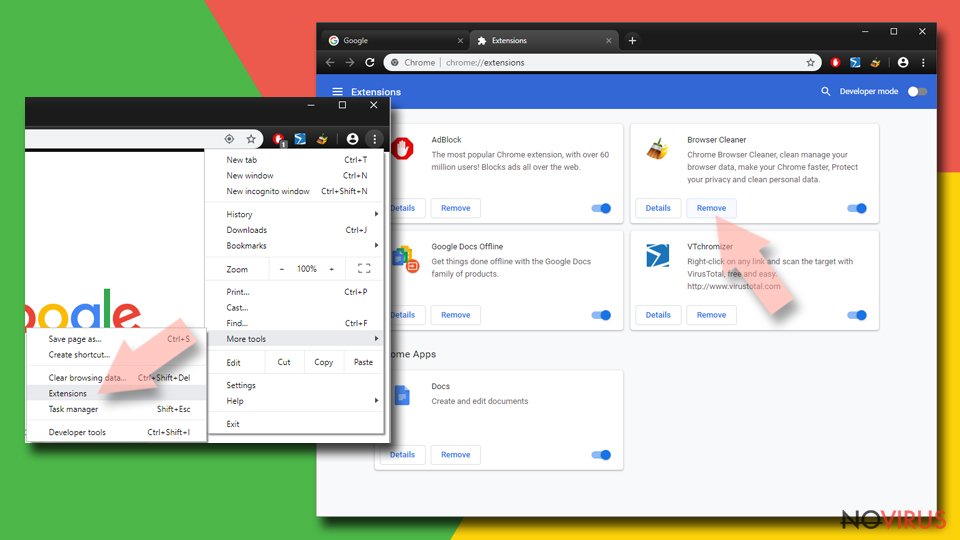
Clear cache and web data from Chrome:
- Click the Menu and select Settings.
- Find Privacy and security section.
- Choose Clear browsing data.
- Select Browsing history.
- Cookies and other site data, also Cached images and files.
- Click Clear data.
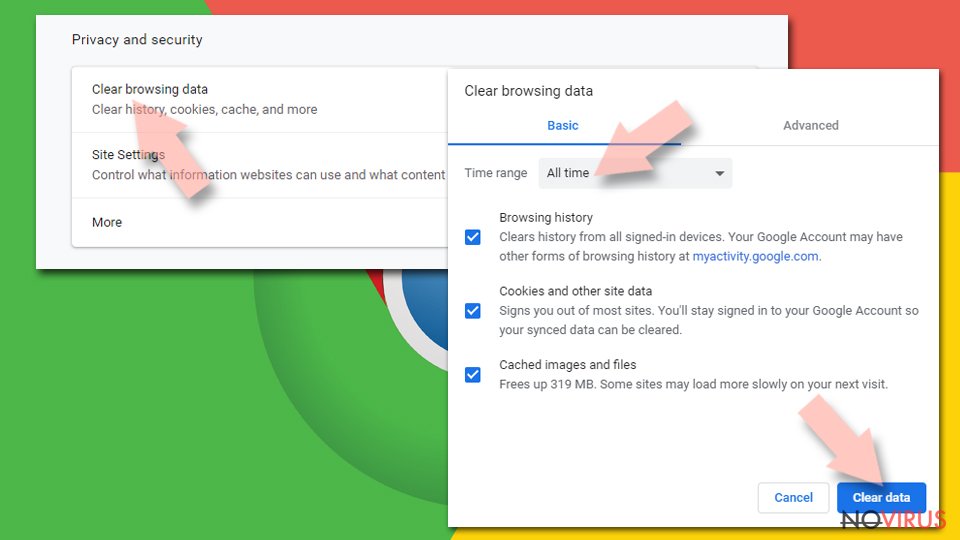
Alter settings of the homepage:
- Go to the menu and choose Settings.
- Find odd entries in the On startup section.
- Click on Open a specific or set of pages.
- Then click on three dots and look for the Remove option.
Reset Google Chrome fully:
You might need to reset Google Chrome and properly eliminate all the unwanted components:
- Go to Chrome Settings.
- Once there, scroll down to expand Advanced section.
- Scroll down to choose Reset and clean up.
- Click Restore settings to their original defaults.
- Click Reset settings again.

Delete Browse for the Cause from Safari
To finish BrowseForTheCause removal, you have to remove all questionable extensions from the Safari that might have been installed without your knowledge.
Get rid of questionable extensions from Safari:
- Click Safari.
- Then go to Preferences…
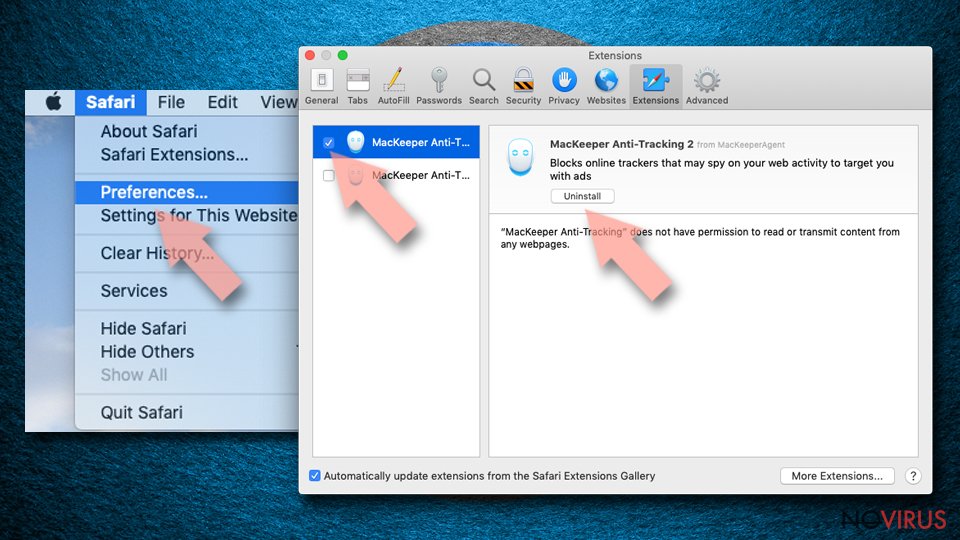
- Choose Extensions on the menu.
- Select the unwanted extension and then pick Uninstall.
Clear cookies from Safari:
- Click Safari.
- Choose Clear History…
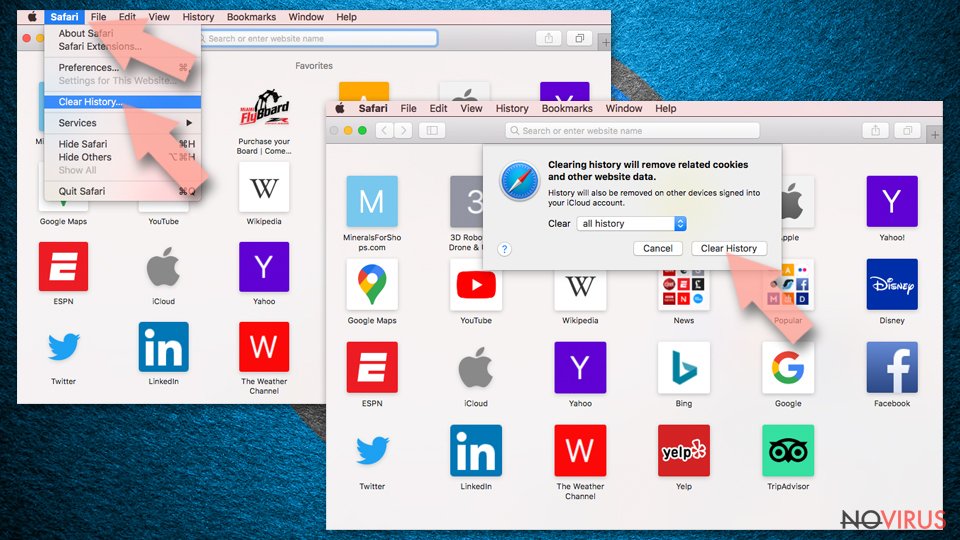
- From the drop-down menu under Clear, find and pick all history.
- Confirm with Clear History.
Reset Safari fully:
- Click Safari and then Preferences…
- Choose the Advanced tab.
- Tick the Show Develop menu in the menu bar.
- From the menu bar, click Develop.
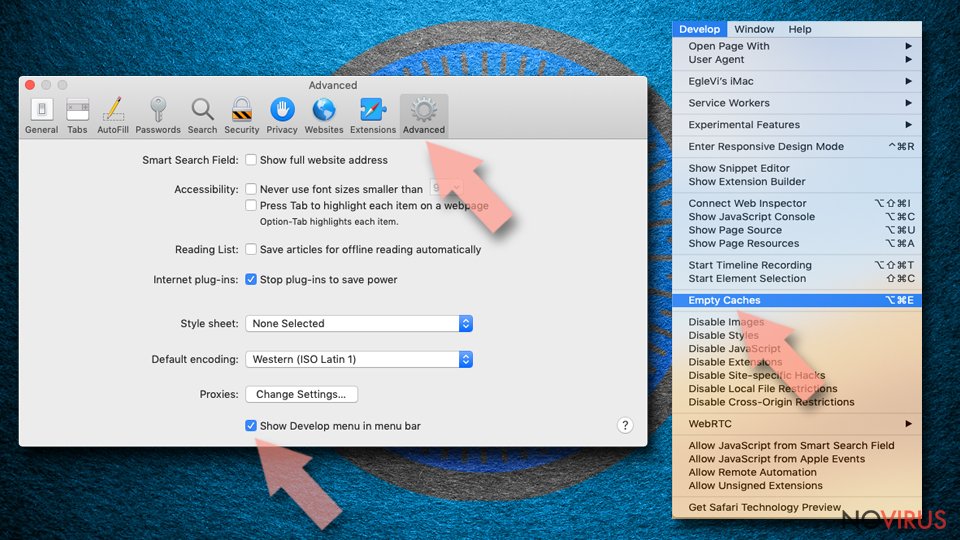
- Then select Empty Caches.
Even if you have completed all the steps above, we still strongly recommend you to scan your computer system with a powerful anti-malware software. It is advisable to do that because an automatic malware removal tool can detect and delete all remains of Browse for the Cause, for instance, its registry keys. The anti-malware program can help you to easily detect and eliminate possibly dangerous software and malicious viruses in an easy way. You can use any of our top-rated malware removal programs: FortectIntego, SpyHunter 5Combo Cleaner or Malwarebytes.
How to prevent from getting adware
A proper web browser and VPN tool can guarantee better safety
As online spying becomes an increasing problem, people are becoming more interested in how to protect their privacy. One way to increase your online security is to choose the most secure and private web browser. But if you want complete anonymity and security when surfing the web, you need Private Internet Access VPN service. This tool successfully reroutes traffic across different servers, so your IP address and location remain protected. It is also important that this tool is based on a strict no-log policy, so no data is collected and cannot be leaked or made available to first or third parties. If you want to feel safe on the internet, a combination of a secure web browser and a Private Internet Access VPN will help you.
Reduce the threat of viruses by backing up your data
Due to their own careless behavior, computer users can suffer various losses caused by cyber infections. Viruses can affect the functionality of the software or directly corrupt data on your system by encrypting it. These problems can disrupt the system and cause you to lose personal data permanently. There is no such threat if you have the latest backups, as you can easily recover lost data and get back to work.
It is recommended to update the backups in parallel each time the system is modified. This way, you will be able to access the latest saved data after an unexpected virus attack or system failure. By having the latest copies of important documents and projects, you will avoid serious inconveniences. File backups are especially useful if malware attacks your system unexpectedly. We recommend using the Data Recovery Pro program to restore the system.
- ^ Brandy. What Are Potentially Unwanted Programs. The High Tech Society. Tech News, Revviews .
- ^ Olivia Morelli. What is adware and how to remove it. 2-spyware. The website about spyware, malware and adware removal.
- ^ Sean Ford, Marco Cova, Christopher Kruegel, and Giovanni Vigna. Analyzing and Detecting Malicious Flash Advertisements. Department of Computer Science. University of California, Santa Barbara. United States {odo,marco,chris,vigna}@cs.ucsb.edu.
- ^ What Is PPC? Learn the Basics of Pay-Per-Click (PPC) Marketing. Word Stream. Online Advertising Made Easy.
- ^ Bundled software. Cimputer Hope. Free computer help and information.

